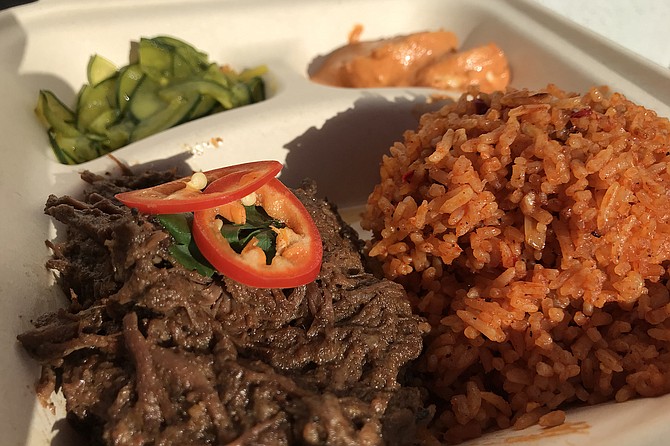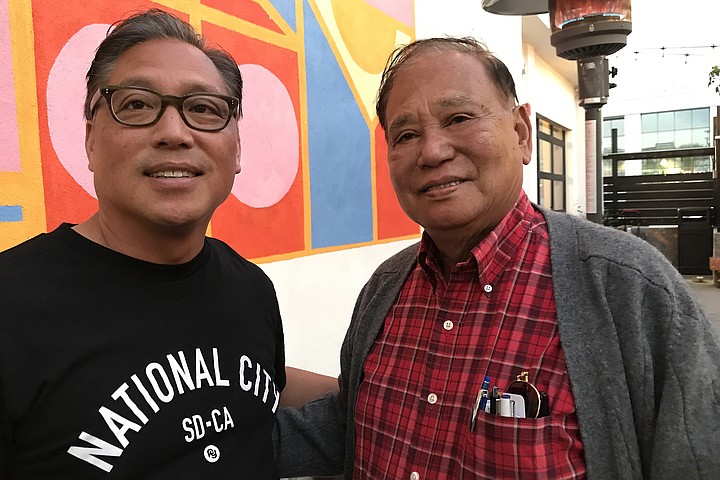 Facebook
Facebook
 X
X
 Instagram
Instagram
 TikTok
TikTok
 Youtube
Youtube

Say what? As my 929 stretch limo (read: bus) hauls me through National City, we pass a big ol’ sprawling furniture place that I remember used to take up most of the block here at 8th and A. No more. Looks like the building has been gutted and, well, reimagined.
“Market On 8th,” says its new sign. I jump off the bus, cross 8th, and march straight into this — wow — brand-new internal public market-type space with tables, chairs, very cool food stalls, a bar selling Novo Brazil beers and kombuchas, couches, a guy playing live Hawaiian music, and a lot of cool people: working their laptops, snoozing in couches, chatting. And this at three in the afternoon! The thing that hits me right off is how, well, tasteful everything is. Not cutesy, but fearless colors, clever signage. This is pro design. Like the Japanese pizza place here: its pies look like art.

“All the food businesses are Asian,” says this guy, Joel, “owned by minorities. No chains.” A bunch of ladies fill one long table. Kinda social meeting. “Until this opened, there was no place to meet in National City,” says Joel. “And see these tables and chairs and stools? We made them all out of the ancient timbers of the building next door.” The wood’s beautiful. Solid. So, where to sit? Where to eat? First thing I see is a coffee place, of course, (Moe Coffee), then a number of small but sophisticated places like Donburi, a Japanese rice bowl shop; Novo, the Brazilian beer and kombucha bar from Chula Vista; and The Fresh Yard, a clothing — and bicycle? — shop. Further in, Weapon Ramen sits right next to an eccentric place called Wordsmith, which sells succulents and, if you can believe it, books, including one I’m desperate for, an Anthony Bourdain collection for around $35. The Japanese pizza joint cozies up to a Mexican taco/birrieria, “La Central.” And next door, hey hey! Cafe Indonesia. “Pinoy-adapted Indo-Dutch food,” it says.
Huh. Got to try. Have never been quite sure what Indonesian food is like, anyway. Thai? Malay? Chinese? Filipino? What makes it Indonesian? Turns out, Indian and Chinese are the heavy culinary influencers, for sure. You could say Indonesia is where curry met fried rice. This all comes out in the menu here. For starters: a whole lot of fusion going on: adobo fried chicken ($13) is obviously a Filipino dish, and so is the chori burger ($13, with fries), which is usually made with a chorizo patty and banana ketchup. Very Filipino.

So, uh, where’s the Indonesian? Turns out there’s plenty, but the most famously Indonesian food here has to be the different choices of satay. Seems the “meats skewered on bamboo spikes” idea started in Java, centuries ago. The Javanese — and all Indonesians — loved their invention so much, it’s now a national dish — almost a pan-Asian national dish. For cooking over hot coals, it’s the perfect setup: little chunks of grilled meat, usually marinated in coconut milk and garlic, on sticks. Plus of course, gotta have peanut sauce. They have sate ayam (chicken), and sate babi (pork), each a crowd of loaded satay sticks for $13. How popular is satay? There’s already another place here, Ping Yang, which features almost exactly the same thing: skewered meat, but Thai-style. “We are Indo-Dutch,” reiterates Robert, Cafe Indonesia’s owner. Oh yeah, I remember hearing that at school: Indonesia was a Dutch East-Indies colony back in the day. But as Robert reminds me, long before that, Java itself was the ruler of its own mighty maritime empires.
Turns out beef rendang is another ancient dish, hailing from Sumatra. It means “slow-cooked (in coconut milk).” And that, deliciously, is what it tastes of, along with sos ikan. Fish sauce. Like Nuoc Mam, Vietnam’s famous fish sauce, it helps you get sweet and sour in the same mouthful. I went ahead and ordered the beef rendang ($14), along with a pint of Novo Brazil beer, “The Mango” ($7.50), from Alejandro the barman. Good. IPA. Only slightly fruity.

The rendang dish also has acar (pickled shallots), and a hard-boiled egg in a thick shrimpy curry sauce. The nasi goreng rice is fine (I chose it over white rice), but it’s the taste of the beef that provides the zap. Particularly with the hot sauce they bring to the table. And rich? The base mix is a curry, loaded with cinnamon, cardamom, star anise, lemon grass, garlic, ginger and galangal. Intense flavors! They make it dry-ish, so there’s less of it. But it’s still a lovely flavor. Goes well with the nasi goreng and its shrimp taste. And cloves. And coconut milk. And that touch of acar.
I take it all outside to the beer garden-patio. “We came down from Pasadena specifically for this place,” says Brian. I’ve joined him and his bud Michelle in the patio’s sunshine. “Look at all these different Asian food outlets, and no big-ass companies. They’re all locals. It’s like being in Singapore.”
I talk, slurp, and bite into this ragout. Delish.
They say the nasi goreng is another Indonesian national dish. It translates as “fried rice,” but it usually tastes more smoky and also caramelized compared to standard fried rice.
I get talking to Joel. Turns out this project is his baby. He’s here with his dad, Gerry, who’s 85. “I was born in the Philippines,” Gerry says. “I served 20 years in the U.S. Navy. But when I was based here, I slowly started buying property in National City, and then with my family, we started building. Now we have created this, for the community. And we keep on building.” Joel, who runs this whole project, looks at his dad with pride. “He started everything,” he says, “from nothing. He did it for our family, and also for National City.”


Say what? As my 929 stretch limo (read: bus) hauls me through National City, we pass a big ol’ sprawling furniture place that I remember used to take up most of the block here at 8th and A. No more. Looks like the building has been gutted and, well, reimagined.
“Market On 8th,” says its new sign. I jump off the bus, cross 8th, and march straight into this — wow — brand-new internal public market-type space with tables, chairs, very cool food stalls, a bar selling Novo Brazil beers and kombuchas, couches, a guy playing live Hawaiian music, and a lot of cool people: working their laptops, snoozing in couches, chatting. And this at three in the afternoon! The thing that hits me right off is how, well, tasteful everything is. Not cutesy, but fearless colors, clever signage. This is pro design. Like the Japanese pizza place here: its pies look like art.

“All the food businesses are Asian,” says this guy, Joel, “owned by minorities. No chains.” A bunch of ladies fill one long table. Kinda social meeting. “Until this opened, there was no place to meet in National City,” says Joel. “And see these tables and chairs and stools? We made them all out of the ancient timbers of the building next door.” The wood’s beautiful. Solid. So, where to sit? Where to eat? First thing I see is a coffee place, of course, (Moe Coffee), then a number of small but sophisticated places like Donburi, a Japanese rice bowl shop; Novo, the Brazilian beer and kombucha bar from Chula Vista; and The Fresh Yard, a clothing — and bicycle? — shop. Further in, Weapon Ramen sits right next to an eccentric place called Wordsmith, which sells succulents and, if you can believe it, books, including one I’m desperate for, an Anthony Bourdain collection for around $35. The Japanese pizza joint cozies up to a Mexican taco/birrieria, “La Central.” And next door, hey hey! Cafe Indonesia. “Pinoy-adapted Indo-Dutch food,” it says.
Huh. Got to try. Have never been quite sure what Indonesian food is like, anyway. Thai? Malay? Chinese? Filipino? What makes it Indonesian? Turns out, Indian and Chinese are the heavy culinary influencers, for sure. You could say Indonesia is where curry met fried rice. This all comes out in the menu here. For starters: a whole lot of fusion going on: adobo fried chicken ($13) is obviously a Filipino dish, and so is the chori burger ($13, with fries), which is usually made with a chorizo patty and banana ketchup. Very Filipino.

So, uh, where’s the Indonesian? Turns out there’s plenty, but the most famously Indonesian food here has to be the different choices of satay. Seems the “meats skewered on bamboo spikes” idea started in Java, centuries ago. The Javanese — and all Indonesians — loved their invention so much, it’s now a national dish — almost a pan-Asian national dish. For cooking over hot coals, it’s the perfect setup: little chunks of grilled meat, usually marinated in coconut milk and garlic, on sticks. Plus of course, gotta have peanut sauce. They have sate ayam (chicken), and sate babi (pork), each a crowd of loaded satay sticks for $13. How popular is satay? There’s already another place here, Ping Yang, which features almost exactly the same thing: skewered meat, but Thai-style. “We are Indo-Dutch,” reiterates Robert, Cafe Indonesia’s owner. Oh yeah, I remember hearing that at school: Indonesia was a Dutch East-Indies colony back in the day. But as Robert reminds me, long before that, Java itself was the ruler of its own mighty maritime empires.
Turns out beef rendang is another ancient dish, hailing from Sumatra. It means “slow-cooked (in coconut milk).” And that, deliciously, is what it tastes of, along with sos ikan. Fish sauce. Like Nuoc Mam, Vietnam’s famous fish sauce, it helps you get sweet and sour in the same mouthful. I went ahead and ordered the beef rendang ($14), along with a pint of Novo Brazil beer, “The Mango” ($7.50), from Alejandro the barman. Good. IPA. Only slightly fruity.

The rendang dish also has acar (pickled shallots), and a hard-boiled egg in a thick shrimpy curry sauce. The nasi goreng rice is fine (I chose it over white rice), but it’s the taste of the beef that provides the zap. Particularly with the hot sauce they bring to the table. And rich? The base mix is a curry, loaded with cinnamon, cardamom, star anise, lemon grass, garlic, ginger and galangal. Intense flavors! They make it dry-ish, so there’s less of it. But it’s still a lovely flavor. Goes well with the nasi goreng and its shrimp taste. And cloves. And coconut milk. And that touch of acar.
I take it all outside to the beer garden-patio. “We came down from Pasadena specifically for this place,” says Brian. I’ve joined him and his bud Michelle in the patio’s sunshine. “Look at all these different Asian food outlets, and no big-ass companies. They’re all locals. It’s like being in Singapore.”
I talk, slurp, and bite into this ragout. Delish.
They say the nasi goreng is another Indonesian national dish. It translates as “fried rice,” but it usually tastes more smoky and also caramelized compared to standard fried rice.
I get talking to Joel. Turns out this project is his baby. He’s here with his dad, Gerry, who’s 85. “I was born in the Philippines,” Gerry says. “I served 20 years in the U.S. Navy. But when I was based here, I slowly started buying property in National City, and then with my family, we started building. Now we have created this, for the community. And we keep on building.” Joel, who runs this whole project, looks at his dad with pride. “He started everything,” he says, “from nothing. He did it for our family, and also for National City.”